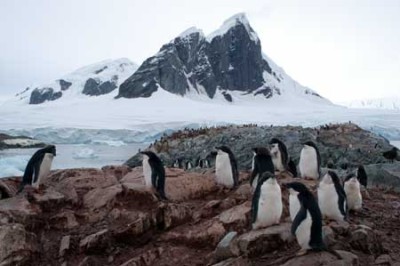
03 March 2007 | Position 55 49.5'S 67 30.7'W
01 March 2007 | Position 58 34'S 67 00'W
24 February 2007 | Position 64 19.5'S 62 55'W
22 February 2007 | Position 64 54'S 62 52'W
20 February 2007 | Position 64 49'S 63 30'W
20 February 2007 | Position 64 49'S 63 30'W
18 February 2007 | Position 65 06'S 64 04'W
16 February 2007 | Position 65 06'S 64 04'W
14 February 2007 | Position 65 26'S 65 22'W
11 February 2007 | Position 66 02'S 65 24'W
09 February 2007 | Position 66 02'S 65 24'W
06 February 2007 | Position 66 52'S 66 47'W
05 February 2007 | Position 66 02'S 65 24'W
04 February 2007 | Position 66 02'S 65 24'W
02 February 2007 | Position 65 08'S 64 02'W
28 January 2007 | Position 64 49'S 63 30'W
26 January 2007 | Position 64 49'S 63 30'W
25 January 2007 | Position 64 32'S 62 00'W
25 January 2007 | Position 64 32'S 62 00'W
24 January 2007 | Position 64 32'S 62 00'W
Pitt Islands
14 February 2007 | Position 65 26'S 65 22'W

Yesterday we sailed north to the Pitt Islands where we negotiated our way into a sheltered cove through a series of channels between small islands. This island group is on the ocean side of the Grandidier Channel about 30 miles from the Antarctic Peninsula and consists of many low, snow-domed islets, quite different from the mountainous scenery of the mainland. The highlight of the last few days has been spending much time with Adelie Penguins (see photo). First at our previous anchorage and today here we have spent many hours sitting amongst the birds. Most of the chicks are partially fledged but still sport tufts of fluff on their heads and backs. They are almost as big as the adults now and we saw a number of them make a tentative foray into the water. It is clear from their behaviour that they are experimenting and testing themselves, learning how to swim and it is fantastic to watch their uncertain encounters with the sea. They hover at the edge, sticking their heads under the surface or wading into the shallows for a trial submersion. You sense their inquisitiveness and surprise as some rush out again at once, shaking themselves and flapping their flippers. Others go straight in and we saw one trying to dive under with its head down and orange feet kicking in the air - it didn't quite have the hang of buoyancy control yet! Feeding chases happen all around, with the chicks pursuing the adults at high speed across the rocks before they receive a meal. Already there is a feeling that the season is winding down and a few adults have begun moulting, a process they go through to replace their feathers every year at the end of the breeding season.
Comments
| Vessel Name: | Wandering Albatross |
Gallery not available